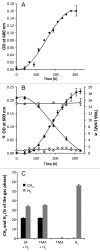Archaebiotics: proposed therapeutic use of archaea to prevent trimethylaminuria and cardiovascular disease
- PMID: 24247281
- PMCID: PMC4049937
- DOI: 10.4161/gmic.26749
Archaebiotics: proposed therapeutic use of archaea to prevent trimethylaminuria and cardiovascular disease
Abstract
Trimethylamine (TMA) is produced by gut bacteria from dietary ingredients. In individuals with a hereditary defect in flavin-containing monooxygenase 3, bacterial TMA production is believed to contribute to the symptoms of trimethylaminuria (TMAU; fish-odor syndrome). Intestinal microbiota TMA metabolism may also modulate atherosclerosis risk by affecting trimethylamine oxide (TMAO) production levels. We propose that reducing TMA formation in the gut by converting it to an inert molecule could be used to prevent or limit these human diseases, while avoiding the major drawbacks of other clinical interventions. Reducing TMA levels by microbiological interventions could also be helpful in some vaginoses. Particular members of a recently discovered group of methanogens, that are variably present in the human gut, are unusual in being apparently restricted to utilizing only methyl compounds including TMA as substrates. We confirmed experimentally that one of these strains tested, Methanomassiliicoccus luminyensis B10, is able to deplete TMA, by reducing it with H 2 for methanogenesis. We therefore suggest that members of this archaeal lineage could be used as treatments for metabolic disorders.
Keywords: L-carnitine; Methanomassiliicoccusspp; TMA; TMAO; archaebiotics; cardiovascular disease (CVD); choline; thermoplasmata-related methanogens; trimethylaminuria (TMAU); vaginosis.
Figures



Similar articles
-
Trimethylamine and Trimethylamine N-Oxide, a Flavin-Containing Monooxygenase 3 (FMO3)-Mediated Host-Microbiome Metabolic Axis Implicated in Health and Disease.Drug Metab Dispos. 2016 Nov;44(11):1839-1850. doi: 10.1124/dmd.116.070615. Epub 2016 May 17. Drug Metab Dispos. 2016. PMID: 27190056 Free PMC article. Review.
-
Archaea, specific genetic traits, and development of improved bacterial live biotherapeutic products: another face of next-generation probiotics.Appl Microbiol Biotechnol. 2020 Jun;104(11):4705-4716. doi: 10.1007/s00253-020-10599-8. Epub 2020 Apr 12. Appl Microbiol Biotechnol. 2020. PMID: 32281023 Review.
-
Suppression of intestinal microbiota-dependent production of pro-atherogenic trimethylamine N-oxide by shifting L-carnitine microbial degradation.Life Sci. 2014 Nov 11;117(2):84-92. doi: 10.1016/j.lfs.2014.09.028. Epub 2014 Oct 7. Life Sci. 2014. PMID: 25301199
-
Diagnosis of suspected trimethylaminuria by NMR spectroscopy.Clin Chim Acta. 2005 Jan;351(1-2):149-54. doi: 10.1016/j.cccn.2004.09.006. Clin Chim Acta. 2005. PMID: 15563884
-
Treatments of trimethylaminuria: where we are and where we might be heading.Drug Discov Today. 2020 Sep;25(9):1710-1717. doi: 10.1016/j.drudis.2020.06.026. Epub 2020 Jun 29. Drug Discov Today. 2020. PMID: 32615074 Review.
Cited by
-
The association between the gut microbiota metabolite trimethylamine N-oxide and heart failure.Front Microbiol. 2024 Sep 26;15:1440241. doi: 10.3389/fmicb.2024.1440241. eCollection 2024. Front Microbiol. 2024. PMID: 39391607 Free PMC article.
-
Unraveling the environmental and genetic interactions in atherosclerosis: Central role of the gut microbiota.Atherosclerosis. 2015 Aug;241(2):387-99. doi: 10.1016/j.atherosclerosis.2015.05.035. Epub 2015 Jun 3. Atherosclerosis. 2015. PMID: 26071662 Free PMC article. Review.
-
Trimethylamine N-Oxide: The Good, the Bad and the Unknown.Toxins (Basel). 2016 Nov 8;8(11):326. doi: 10.3390/toxins8110326. Toxins (Basel). 2016. PMID: 27834801 Free PMC article. Review.
-
Trimethylamine and Trimethylamine N-Oxide, a Flavin-Containing Monooxygenase 3 (FMO3)-Mediated Host-Microbiome Metabolic Axis Implicated in Health and Disease.Drug Metab Dispos. 2016 Nov;44(11):1839-1850. doi: 10.1124/dmd.116.070615. Epub 2016 May 17. Drug Metab Dispos. 2016. PMID: 27190056 Free PMC article. Review.
-
Methanogenic archaea in the human gastrointestinal tract.Nat Rev Gastroenterol Hepatol. 2022 Dec;19(12):805-813. doi: 10.1038/s41575-022-00673-z. Epub 2022 Sep 1. Nat Rev Gastroenterol Hepatol. 2022. PMID: 36050385 Review.
References
-
- Institute of Medicine (U.S.). Standing Committee on the Scientific Evaluation of Dietary Reference Intakes., Institute of Medicine (U.S.). Panel on Folate Other B Vitamins and Choline., Institute of Medicine (U.S.). Subcommittee on Upper Reference Levels of Nutrients. Dietary reference intakes for thiamin, riboflavin, niacin, vitamin B6, folate, vitamin B12, pantothenic acid, biotin, and choline. Washington, D.C.: National Academy Press, 1998. - PubMed
-
- Buchman AL, Dubin MD, Moukarzel AA, Jenden DJ, Roch M, Rice KM, Gornbein J, Ament ME. Choline deficiency: a cause of hepatic steatosis during parenteral nutrition that can be reversed with intravenous choline supplementation. Hepatology. 1995;22:1399–403. - PubMed
Publication types
MeSH terms
Substances
Supplementary concepts
LinkOut - more resources
Full Text Sources
Other Literature Sources
